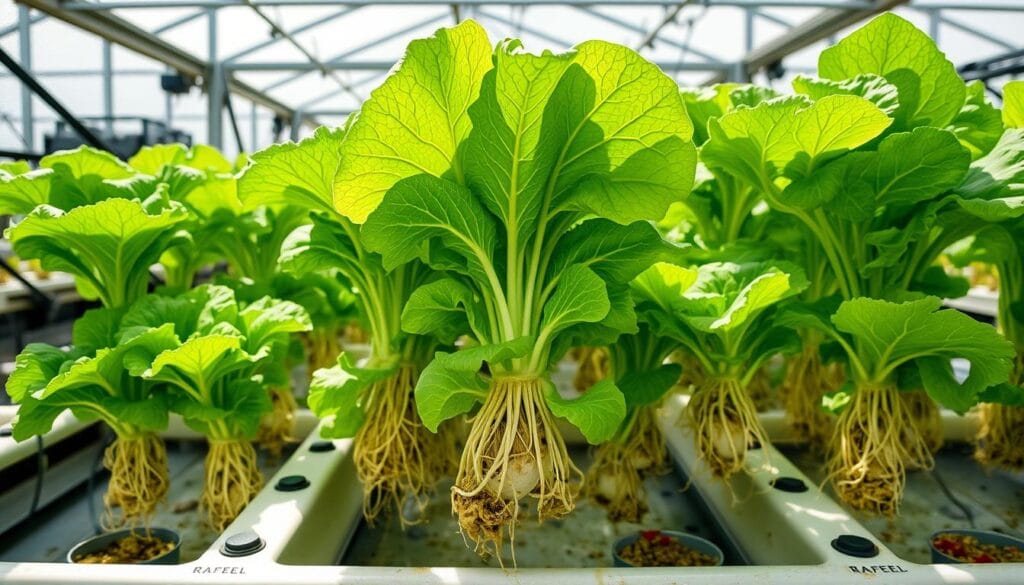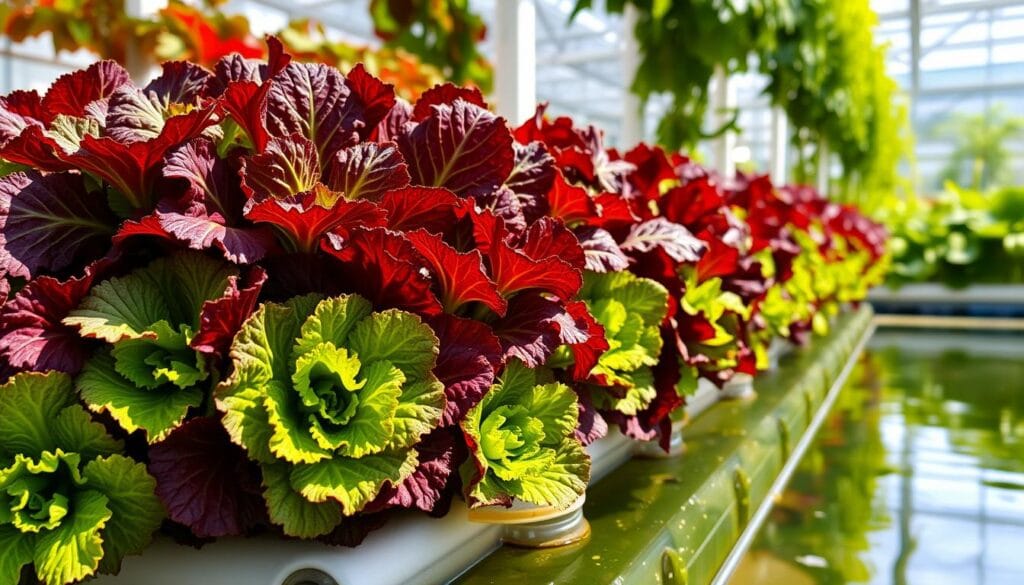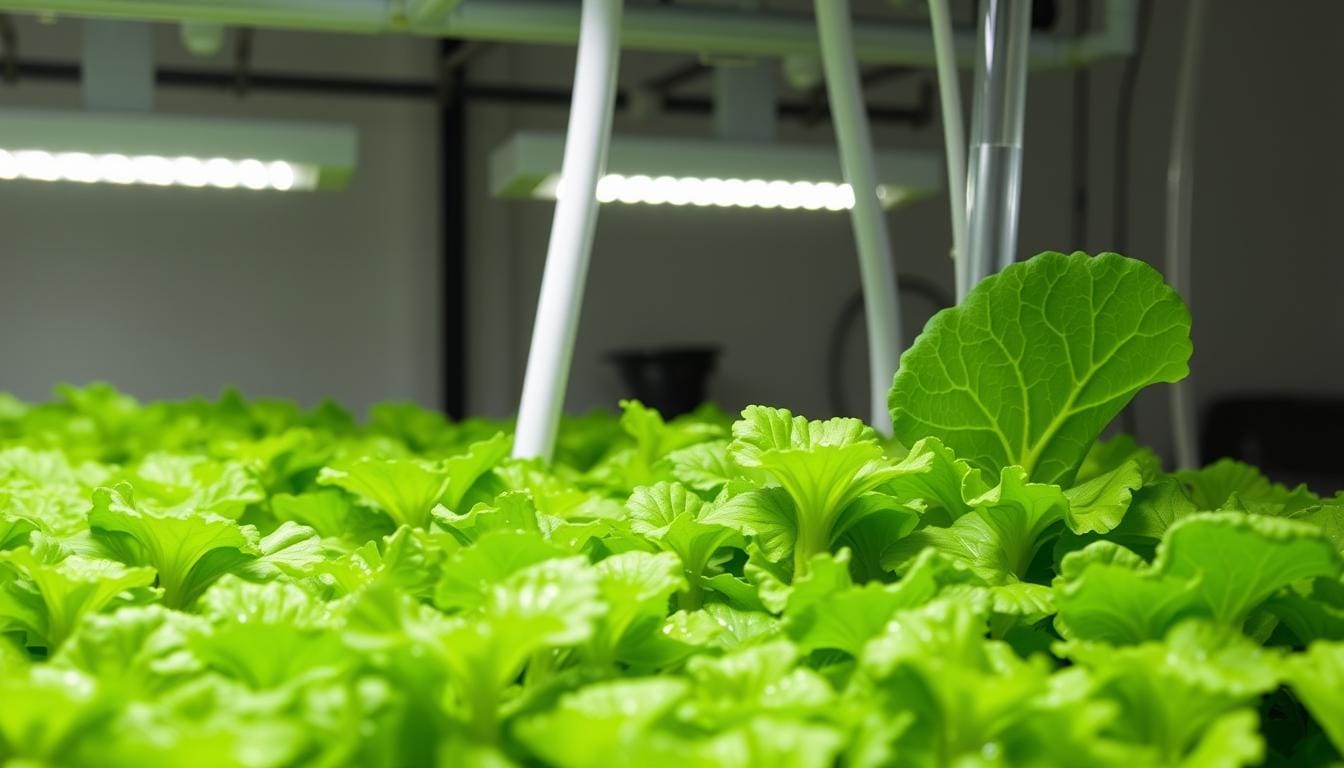Starting to grow your lettuce can be thrilling and a bit scary. But, there’s a new way to grow lettuce that’s easy and good for the planet. This method is called hydroponic Rafael lettuce, perfect for new gardeners in 2024.
Imagine having a green lettuce garden at home, without the need for soil or constant watering. Hydroponic systems change how we grow greens, making it simple and efficient. Rafael lettuce is great for this method because it tastes amazing and is very healthy.
Key Takeaways
- Discover the advantages of hydroponic growing for beginner gardeners
- Learn about the exceptional qualities of Rafael lettuce and its health benefits
- Understand the environmental impact of sustainable hydroponic farming
- Explore the cost-effective and space-efficient nature of hydroponic systems
- Get inspired to start your own hydroponic Rafael lettuce garden in 2024
Understanding the Rise of Hydroponic Lettuce Cultivation
The world is seeing more hydroponic lettuce farming because of a big need for green and smart farming. People are moving away from old farming ways to controlled environment agriculture and urban farming. This change is happening because of worries about the environment and using less resources.
Global Market Trends and Statistics
Lettuce is a top veggie in the U.S. and the second-biggest producer after China. In Mexico, they send out 260,000 tons of lettuce every year. Most of it goes to the U.S., Canada, and Japan. Guanajuato, located in Mexico, is the largest producer of lettuce, accounting for 28% of the nation’s total lettuce production.
The Shift from Traditional to Hydroponic Farming
More people are choosing soilless cultivation because it’s better for the planet and more efficient. Hydroponics save water, grow food all year, and use less space. This makes them perfect for cities and areas close to cities.
Environmental Benefits of Soilless Growing
Hydroponics are becoming more popular worldwide because they use less fertilizer and are better for the environment. The system recycles water and nutrients, which helps plants grow. Using UV-C technology helps keep the water clean and safe for plants.
“The UV-C decontamination system used in hydroponic solutions during nutrient recirculation has proven effective in enhancing plant growth and improving nutrient content.”
Essential Nutrients and Health Benefits of Rafael Lettuce
Rafael lettuce is a nutrient-rich vegetable from the leafy greens family. It’s a great choice for those looking to improve their health. This hydroponic lettuce is packed with vitamins and minerals.
It is exceptionally high in vitamins A, K, and C. These vitamins boost the immune system, help the eyes stay healthy, and aid in blood clotting. Rafael lettuce also has beta-carotene, an antioxidant that protects cells and may lower disease risk.
The nutrients in leafy greens like Rafael lettuce can change based on how they’re grown. For example, the calcium, phosphorus, and zinc in green leafy vegetables can vary. This shows how important growing conditions are for nutrient levels.
Even though Rafael lettuce is very nutritious, it also has anti-nutrients. These include nitrates, phytates, tannins, and oxalates. These can affect how well some nutrients are absorbed. Therefore, incorporating Rafael lettuce into a balanced diet is essential.
“Leafy greens like Rafael lettuce are true nutrient-rich vegetables that can offer a wealth of health benefits when incorporated into a well-rounded diet.”
Knowing about Rafael lettuce’s nutrients and health benefits helps people make better food choices. It’s a way to add a nutrient-dense, sustainable food to your daily meals.
Getting Started with Hydroponic Rafael Lettuce
Starting a hydroponic journey with Rafael lettuce is exciting and rewarding for beginners. You’ll need the right equipment and know the setup basics. There are many ways to grow hydroponic Rafael lettuce, like NFT systems and aquaponics.
Basic Equipment Requirements
For a good hydroponic setup, you need grow lights, nutrient solutions, and a water system. Depending on your method, you might also need grow trays, air pumps, and pH kits.
Setting Up Your First System
Setting up your first hydroponic system for Rafael lettuce requires careful planning. You must consider water quality, nutrient balance, and lighting. Learning about NFT or aquaponics can help your plants grow well. It’s key to understand pH levels, nutrient ratios, and light needs for your plants.
Cost Considerations for Beginners
Starting a hydroponic system for Rafael lettuce has initial costs, but it’s worth it in the long run. The size of your system, equipment choice, and maintenance costs affect the total cost. Beginners should compare different methods to find the best and most affordable option.
By knowing what equipment you need, setting up your system, and thinking about costs, you can start growing your own hydroponic Rafael lettuce. With the right approach and care, you can enjoy the benefits of this sustainable way to grow fresh, nutritious lettuce.
Hydroponic Growing Techniques for Optimal Results
Successful hydroponic lettuce growing needs careful attention to light, temperature, humidity, and nutrient solution. The field of vertical farming and controlled environment agriculture is growing fast. New tech is changing farming, helping growers use less water, cut down on pesticides, and work more efficiently.
The ScanSeedling v2.0 prototype is a big leap in hydroponic growing. It’s a 3D scanner that spots nutrient problems and helps plants grow better. This tool gives growers the info they need to improve their hydroponic setups and grow more lettuce.
Ultraviolet (UV-C) light is also making a big difference. It kills off harmful microbes in hydroponic solutions. Research shows UV-C light can kill microbes faster, help plants absorb nutrients better, and make lettuce grow stronger.
| Key Findings from UV-C Research | Results |
|---|---|
| Microbial population levels | Reached a maximum of 2.9 CFU/mL with UV-C exposure, compared to 4.5 CFU/mL without |
| Microbial death phase | Shortened by 3 days with UV-C treatment |
| Plant growth and nutrition | Faster maximum height, higher pigment content, phenolic compounds, and antioxidant capacity |
By using these new technologies and methods, hydroponic growers can improve their lettuce production. They can provide fresh, nutritious lettuce while being kinder to the environment and more efficient.
The Advantages of Growing Hydroponic Rafael Lettuce
Hydroponic cultivation of Rafael lettuce is changing the game in sustainable agriculture. It uses soilless growing methods to produce fresh, nutritious greens. This is especially beneficial in urban areas.
Water Conservation Benefits
Hydroponic Rafael lettuce grows with up to 90% less water than traditional farming. This makes it a great choice for growing lettuce indoors. It’s perfect for areas with water scarcity or drought.
Year-Round Growing Capability
Hydroponic setups allow for growing lettuce all year round. This means you can have fresh, crisp Rafael lettuce anytime. It’s a reliable choice for both commercial and home growers.
Space Efficiency Advantages
Hydroponic systems use space wisely, making them perfect for urban farming and small growing spaces. You can stack trays or use vertical towers to grow a lot in a little space. This is great for growing food in crowded areas.
Growing hydroponic Rafael lettuce shows the power of new farming methods. It saves water, grows food all year, and uses space well. Hydroponic growers help make our food system more sustainable and resilient.
Common Challenges and Solutions in Hydroponic Lettuce Growing
Growing hydroponic lettuce comes with its own set of challenges. But, with the right strategies, growers can overcome these and get great results. One big issue is keeping the right balance of nutrients in the growing medium. Lettuce needs specific nutrients like nitrogen, phosphorus, and potassium.
Another challenge is stopping diseases and pests. Hydroponic systems can get sick if they’re not kept clean. Keeping everything sanitized and checking the water quality regularly can help prevent this.
Energy costs for hydroponic systems can also be a big deal. But, new LED lights and climate control systems help cut down on energy use and costs.
Addressing Nutrient Management Challenges
To keep nutrients right, growers should check the pH and EC of the solution often. Keeping the pH between 5.5 and 6.5 and the EC between 1.5 and 2.5 mS/cm helps plants get the nutrients they need.
Implementing Effective Hygiene Protocols
Keeping everything clean is key in hydroponic lettuce growing. This means cleaning and disinfecting the system, using sterile tools, and watching for any signs of germs. Using automated systems and AI can help with this by giving real-time data and making adjustments.
Optimizing Energy Efficiency
Using energy-saving LED grow lights can cut down on electricity use while still giving lettuce the light it needs. Keeping the right temperature and humidity also helps save energy and keep growing conditions perfect.
By tackling these challenges with good nutrient management, disease prevention, and energy saving, hydroponic lettuce growers can produce top-quality, nutrient-rich crops. They can do this while using fewer resources and cutting down on costs.

| Challenge | Solution |
|---|---|
| Nutrient imbalance | Regular monitoring of pH and EC levels, adjusting nutrient solution accordingly |
| Disease and pest control | Strict sanitation protocols, use of automated systems and AI-driven technologies |
| High energy costs | Energy-efficient LED lighting, optimized temperature and humidity control |
Maximizing Yield Through Controlled Environment Agriculture
Hydroponic farming lets growers control the growing environment. This control enables them to achieve optimal yield and quality. By using controlled environment agriculture (CEA), hydroponic Rafael lettuce producers can adjust key factors. This unlocks the full potential of their crops.
Light Management Strategies
Light management is key for hydroponic lettuce growth. Growers can adjust light intensity, duration, and spectrum. This meets the plant’s needs at each stage.
Advanced LED lighting systems help create custom light profiles. These profiles boost photosynthesis and enhance leaf and root health.
Temperature and Humidity Control
Keeping the right temperature and humidity is vital for hydroponic lettuce. Growers use climate-controlled environments to keep the ideal range. This range is usually between 65-75°F (18-24°C) and 60-80% relative humidity.
Monitoring and adjusting these parameters ensures consistent, high-quality yields all year.
Nutrient Solution Management
Managing the hydroponic nutrient solution is crucial for maximizing yield in Rafael lettuce. Growers must test and adjust the solution’s pH, electrical conductivity, and nutrient levels. This ensures the plants get the right mix of minerals for growth and flavor.
With controlled environment agriculture, hydroponic Rafael lettuce growers can produce high-quality, year-round yields. These yields meet the growing demand for this nutritious leafy green.
Sustainable Practices in Hydroponic Lettuce Production
The need for sustainable farming is on the rise. Hydroponic lettuce farming is a key player in this trend. It grows plants in water rich with nutrients, not soil. This method has many environmental benefits, leading to a greener future.
Recycling water and nutrients is a big part of hydroponic lettuce farming. This way, growers use less water and cut down on waste. They also use natural pest control methods, avoiding harmful chemicals. This makes the farming process more eco-friendly.
Using renewable energy is another key part of sustainable hydroponic farming. Solar panels can power the system, from pumps to lights. This cuts down on carbon emissions and saves money on energy costs.
| Sustainable Practice | Description | Benefits |
|---|---|---|
| Water and Nutrient Recycling | Recirculating the nutrient solution to minimize water usage and waste | Reduced resource consumption, lower environmental impact |
| Integrated Pest Management | Using biological controls and reducing reliance on chemical pesticides | Decreased chemical pollution, healthier ecosystems |
| Renewable Energy Integration | Incorporating solar panels or other renewable energy sources to power the growing system | Lower carbon footprint, reduced energy costs |
By adopting these sustainable practices, hydroponic lettuce farmers help achieve sustainable agriculture and eco-friendly farming. They meet the growing need for food produced in an environmentally responsible way.
Market Opportunities and Economic Benefits
Urban agriculture and vertical farming are on the rise. The global hydroponic lettuce market is full of chances for growers. People want locally grown, pesticide-free food, making urban agriculture a great place for hydroponic Rafael lettuce.
One big plus of growing hydroponic Rafael lettuce is saving on transport costs. By growing it in cities, growers cut down on shipping. This means fresher, healthier food for everyone and lower costs for growers. Plus, hydroponics can produce food all year, giving growers a steady income.
Hydroponic farming also uses less space than traditional farming. This is ideal for cities with limited land availability. It makes vertical farming a smart and profitable choice.
“One-third of all food produced, capable of feeding the world’s vulnerable populations, goes to waste.”
The benefits of growing hydroponic Rafael lettuce are huge. It helps reduce food waste, makes food more accessible, and provides fresh, nutritious food. This method is key to solving global hunger and ensuring everyone has enough to eat.

The future for growing hydroponic Rafael lettuce looks bright. With more people wanting local, sustainable, and quality food, growers who use this method can make a lot of money. They help create a fairer and more reliable food system for everyone.
Conclusion
Hydroponic Rafael lettuce growing is great for beginners in 2024. It saves water and lets you grow all year. Plus, it uses less space, making it a good choice for growing healthy lettuce.
Using new tech like AI and controlled environments makes growing lettuce even better. This tech helps control the growing space. It lets farmers grow more lettuce with less harm to the environment.
As more people want food grown in a green way, hydroponics will be key. This includes growing Rafael lettuce. With what you’ve learned, you can start growing your own lettuce. You’ll help make farming more sustainable for the future.

